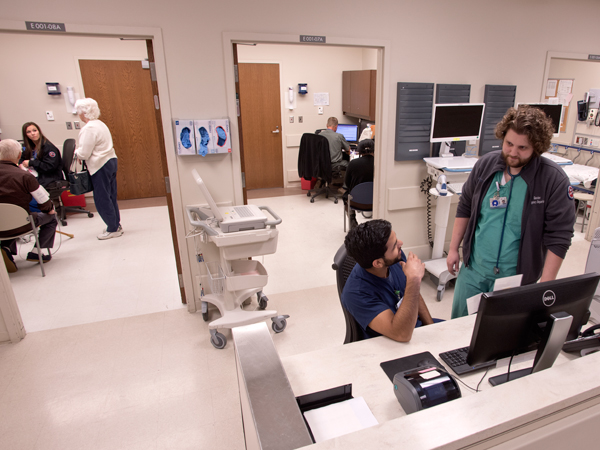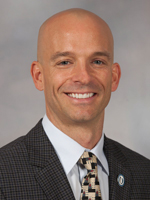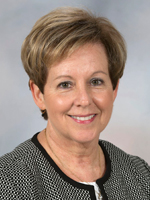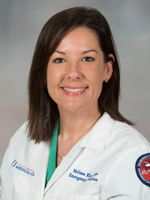Extra staff, efficiency make for shorter ED waits

After patients arrive at the University of Mississippi Medical Center's Emergency Department, they'll see a physician, on average, within 20 minutes.
That's well below the national rate of 32 minutes at hospitals with “very high” patient volume, meaning 60,000-plus people come through their emergency rooms per year. At UMMC, that number is about 70,000, said Dr. Alan Jones, chairman of the Department of Emergency Medicine.
That wait-time statistic comes not just from how many people crowd the ED at a particular time, but through hard work and forward-thinking by Jones and his staff. It's part of an ongoing effort to decrease ED wait times, and to improve efficiency so that throughput of patients will yield better patient care and best use of both hospital and ED beds.

“Our goal is to minimize wait time, so we're always looking at how we utilize our space to make that as short as possible,” Jones said. Not just space, but staffing and the ability to react to a large influx of patients due to a disaster or accidents are being evaluated and ongoing adjustments made.
“Because it's the front door to the hospital, our ability to get people through that front door quickly and efficiently is critical,” said Trish McDaniel, chief operating officer for the adult hospital. “On any typical day, a good part of our inpatient admissions has originated from the ED, and anything we can do from a flow perspective behooves not only the ED, but the hospital.”

A turning point has been the completion of phased-in refurbishings to the ED, with the most recently updated section opening to patients June 1. The work gives Mississippi's only Level 1 trauma center the best state-of-the-art tools to save lives, but also to achieve maximum efficiency. It gives trauma care its own entrance and exit, helping streamline the flow of patients being treated for more routine emergency ailments.
“As part of the renovation, we added 10 beds. There was an expected and observed decrease in the wait time for patients and the time it took for them to get through the system,” Jones said. “But, as a result of the expansion, we've seen skyrocketing volumes of patients, and we're doing things with our operations that are going to accommodate that.”
Among the changes:
- The ED has expanded its coverage by residents and attending physicians. Before the renovation, Jones said, there were two attendings giving 24/7 coverage. “Now, we have three attendings for 12 hours of the day, and two for the other 12,” Jones said. “That gives us an additional 60 hours per week of attending physician coverage, and an extra 60 hours of resident physician coverage.”
- An additional nurse practitioner staffs the ED's triage area for 12 hours a day, adding 60 hours of nurse practitioner coverage each week, Jones said.
- The ED's Rapid Track pod, overseen by attending physicians and staffed by nurse practitioners, sees patients who are not acutely ill, aiding good patient flow and cutting down on the number of patients waiting in the main ED.
“Our plan is to have three attendings in the ED, 24 hours a day,” Jones said. “As we see volume increase and wait times creep back up, we'll expand that coverage so that we can keep the wait times and volume down.”

Adding a nurse practitioner at triage has been a major factor in getting care to patients faster, said Melissa King, director of advanced practice providers in the ED. “It's an additional discipline to start advanced treatment and to work with physicians so that we can see more patients quickly, and we can get EMS back to the streets faster so that they can go get their patients,” King said. “We can quickly start patient workups, order X-rays and get their diagnostic workup expedited.”
King said the additional resident, attending and nurse practitioner coverage, coupled with the recent renovations, has resulted in a decrease in length of stay by more than an hour. “As you start working well with each other, you have better flow,” she said.
“It's been amazing, because the patients are so happy, and staff satisfaction is so much better,” she said. “The patients are verbalizing this, and thanking us for seeing them so quickly. Even if they have to stay a little longer to see a specialist, they know they've been seen, and they have that extra sense of security and know that we care about them.”
McDaniel agrees. “From the patient's perspective, if no movement is happening, then they may perceive that nothing is happening.”
The ED from July-October 2015 saw its highest volume since that time last year, Jones said. In June, for example, 5,670 patients arrived at the ED; that number in July ballooned to 6,004 - a monthly average that's becoming fairly consistent, he said.
“It just shows our volumes are increasing with the renovation, as we expected,” Jones said. “We want to make sure we have the highest occupancy rates for the beds we have, and to keep them available during the day for as long as possible. Our goal is to keep all beds occupied 90 percent of the time.”
“They opened up new beds, they filled them, and they were back to square one” in the continuing quest to decrease wait times, McDaniel said. “There can never be any let-up in working to improving flow in the ED. The volume of patient visits continues to grow. That's good and challenging at the same time.”
Hospital leadership's focus on flow can't waver as well, McDaniel said. “Maintaining efficient (room) turnover across the hospital impacts the ED, sometimes directly and sometimes indirectly,” she said. “The ED patient, if admitted, either goes to the ICU or to a patient unit.”
Jones' department is monitoring the improvements. “We're tracking how we are managing changes to our environment, and how our operations are different when we are having to adapt to a full hospital versus when we're not,” he said.
And with flu season approaching, Jones said, patient volume likely will continue to rise. “We always brace in the winter months for increasing volumes because of influenza and the changing weather. We see an influx of patients with asthma and COPD, and typically during the winter months when people are indoors and around each other more, we see more infectious diseases.”
“I've been around the Medical Center on and off since 1997,” King said. “To see the ED grow as much as it has, and the increase in patient volume, but still have decreases in wait time - it's phenomenal.
“We need to continue to come up with innovative ways to improve the process,” King said. “We need to be sure that patients continue on this route. Patient outcomes are better. Everything is better.”


